THIS POST INCLUDES:
1. Why You Need a Social Media Plan
2. Before you plan 15 mins
3. Plan your social media posts 45 mins
4. Conclusion
5. BONUS TIPS
6. Free Download Annual Social Media Plan Template
WHY YOU NEED A SOCIAL MEDIA PLAN
In this post, we’re going to assume you already have your social media accounts created and that you now want to create a social media content plan. A social media content plan is simply what you are going to post to your social media accounts over a specified time. In this post, we’re looking at an annual plan.
Your social media plan should target your business goals of generating income and also increasing awareness of your art therapy business. The basic goals for using social media in your business are:
- Creating awareness of your therapy practice
- Generating income
- Engaging with networks for the purposes of supporting the 2 goals listed above
You may also have other goals such as providing community education on art therapy and mental health.
Creating content for multiple social media platforms is a lot of work, however, you can create one piece of content that will be shared across multiple social media platform for maximum impact.
Here is an example of how you can turn one blog post into 16 social media posts. For this example, assume you have written an article about art therapy and anxiety.
Assume your blog post about anxiety and art therapy has the following sections contained in the content you’ve written:
- Different reasons why anxiety occurs
- Why art therapy is good for dealing with anxiety
- Types of art therapy exercises you can do to alleviate anxiety
Here is an example of how you would share the one blog post using the above headings:
GENERAL BLOG LINK TITLE: Check out our new blog post about anxiety and art therapy
- Link to blog post on Facebook. Eg Check out our new blog post about anxiety and art therapy
- Link to blog post on Twitter. Eg Check out our new blog post about anxiety and art therapy
- Link to blog post on Pinterest. Eg Check out our new blog post about anxiety and art therapy (use image from blog post to pin)
- Link to blog post on Instagram. Eg Check out our new blog post about anxiety and art therapy (use image from blog post to Instagram)
HIGHLIGHT BLOG POST SECTION TITLE 1: Different reasons why anxiety occurs
- Link to blog post on Facebook. Eg Different reasons why anxiety occur
- Link to blog post on Twitter. Eg Different reasons why anxiety occur
- Link to blog post on Pinterest. Eg Different reasons why anxiety occur (use image from blog post to pin)
- Link to blog post on Instagram. Eg Different reasons why anxiety occur (use image from blog post to Instagram)
HIGHLIGHT BLOG POST SECTION TITLE 2: Why art therapy is good for dealing with anxiety
- Link to blog post on Facebook. Eg Why art therapy is good for dealing with anxiety
- Link to blog post on Twitter. Eg Why art therapy is good for dealing with anxiety
- Link to blog post on Pinterest. Eg Why art therapy is good for dealing with anxiety (use image from blog post to pin)
- Link to blog post on Instagram. Eg Why art therapy is good for dealing with anxiety (use image from blog post to Instagram)
HIGHLIGHT BLOG POST SECTION TITLE 3: Types of art therapy exercises you can do to alleviate anxiety
- Link to blog post on Facebook. Eg Types of art therapy exercises you can do to alleviate anxiety
- Link to blog post on Twitter. Eg Types of art therapy exercises you can do to alleviate anxiety
- Link to blog post on Pinterest. Eg Types of art therapy exercises you can do to alleviate anxiety (use image from blog post to pin)
- Link to blog post on Instagram. Eg Types of art therapy exercises you can do to alleviate anxiety (use image from blog post to Instagram)
The blog post topic above is one that is relevant today and one that will still be relevant in 5 years time. This is called Evergreen Content. Because your content is evergreen, you can schedule multiple links to the same blog post over an extended period of time. This type of structure above could be used over a period of at least 6-12 months.
Sometimes we think that we can only post a blog post once and it is then considered as used content that can’t be referenced again. However, based on standard social media activity, not all of your audience will see the post the first time. Therefore you should post your content a few times to ensure it gets seen. Also, remember that you will always have new readers signing up to your social media accounts. If you post an article on anxiety in March, that means readers you find your Facebook page in August won’t have seen that blog post, so it is a good idea to reshare that content to make sure it is viewed by new readers and by readers you may not have seen it the first time it was posted.
Also, remember that you will always have new readers signing up to your social media accounts. If you post an article on anxiety in March, that means readers you find your Facebook page in August won’t have seen that blog post, so it is a good idea to reshare that content to make sure it is viewed by new readers and by readers you may not have seen it the first time it was posted.
An added benefit of using different headings is that you can test which titles appeal the most to your readers. In the above example, if most of your social media engagement comes from the posts with the heading “Types of art exercises” this may indicate that your readers are interested in art exercises.
In this blog post, we’re going to keep things simple so that you can create an entire year of social media posts in 60 minutes. If you’re a social media expert who spends their entire day working on social media, you can create a more complicated annual plan that focuses on delivering very specific goals. However, if you’re reading this post, you’re most likely a private practice therapist who has limited time to spend on marketing and social media. Our aim in this post is to make sure you can create the most time efficient methods of structuring your social media content.
If you’re reading this post, you’re most likely a private practice therapist who has limited time to spend on marketing and social media. Our aim in this post is to make sure you can create the most time efficient methods of structuring your social media content.
BEFORE YOU PLAN – 15 minutes
TYPE OF CONTENT TO CREATE:
Before you create your social media plan, you should establish how you plan to create content:
1. Generating your own content yourself through blog posts, podcasts, video etc OR
2. Curation of content from other sources OR
3. Both of the above
SET YOUR GOALS:
Before you decide on the details of your social media content, you should set some goals for the benefits you want from social media. Some broad goals that you may want to consider for your business and social media include:
- Increase email list
- Get appointment bookings
- Increase brand awareness
Your goals will then determine the type of posts and the content that you create.
CHOOSE YOUR POST TYPES:
Next, you should choose the type of posts you think you can easily create. For ideas on the type of posts you can create, read our blog post Review of Free Social Media Schedulers
Included in the Review of Free Social Media Schedulers post is a social media checklist to download. The download contains over 30 specific post suggestions. I wouldn’t recommend that you do all 30+ post types as this involves a substantial amount of work to create. I would suggest using the post types that interest you the most and rotate them regularly.
Some post types include:
- Book recommendation
- Fact Sheet
- Pinterest Board Link
- Blog post topic
- Business details
- Top 5 List
- Art Therapy Example
CHOOSE YOUR TOPICS:
To make the process of creating content easier, it’s always best to write about what you know. This means you won’t be spending hours and hours researching topics that you are only vaguely familiar with. Writing about what you know also means you are connecting with your skillset and the services that you offer your clients through your practice.
Some topic ideas for an art therapist include:
- Creating art
- Family therapy
- Depression
- Children and autism
- Anxiety
- Grief
CHOOSE YOUR SOCIAL MEDIA PLATFORMS:
The social media platforms that you use should reflect where your clients can be found. If you aren’t sure which platforms your client demographic uses the most, you may want to try a few and see how your posts perform over a few months. Unfortunately, marketing and social media are not an exact science, so you have to engage in some experimentation until you can gather some data on the response to some of your posts.
You may prefer a specific content creation style that suits you better. For example, you may prefer creating videos, which means you could use YouTube as a social media platform. However, even though YOU like creating videos, your potential client base may have no interest in watching them. Content creation is a delicate blend of keeping yourself interested in using specific social media platforms and directing that content to where your clients visit.
A general guideline for the most common platforms include:
- Facebook – for general audiences (clients and professional networks). Great for creating your brand awareness as Facebook allows long-form written content as well as images and videos.
- Twitter – more beneficial for networking within your industry
- Instagram – more suitable for connecting with clients based on your specific topics eg. Depression, family therapy etc
- Pinterest – more suitable for connecting with clients based on your specific topics eg. Depression, family therapy etc
PLAN YOUR SOCIAL MEDIA POSTS – 45 minutes
We’ve created a social media planner for you to download and use as a template to create your social media content.
Start by creating a schedule for one month based on the type of posts and the topics that you want to cover. Once you have set up your first month, use it as a template for every other month in the year. We’ve included some sample data in the first month of the social media planner.
Once you’ve planned your social media posts, it’s then time to create the actual content. If you need help to develop your content, we have a Blogging Package available in the store. Our blogging package is available in 3 different formats:
- Evernote
- Microsoft Word
- Scrivener
Below is a snapshot of the content within each Blogging Package. You can find more details on each package on the website here.


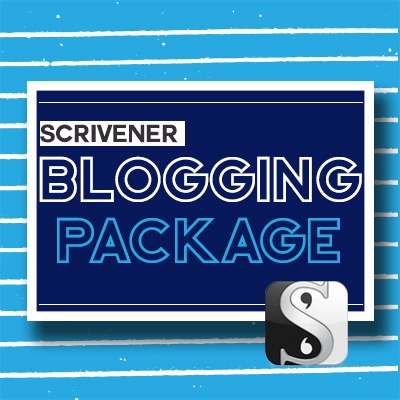
 Scrivener Blogging Package” width=”600″ height=”600″ />
Scrivener Blogging Package” width=”600″ height=”600″ />

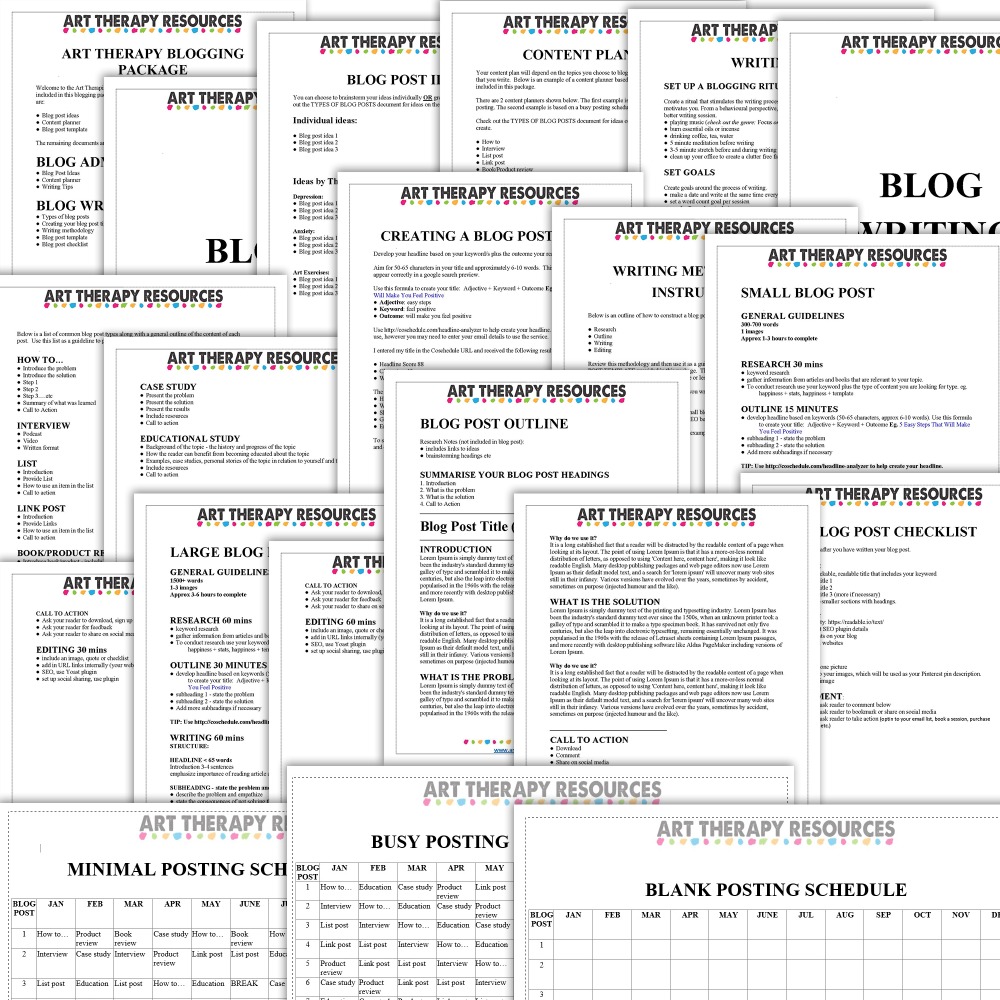
CONCLUSION
Track and analyse your post engagement each month as well as note which social media platforms are growing in readership the most. Some social media platforms such as Facebook provide valuable insights into reader engagement on your page. Based on the information you find, adjust your plan if necessary. This may result in changing the type of posts you make as well as the topics you post about.
One important factor to consider with social media engagement is social media companies rely on you using their advertising services to promote your content. When you are first building your social media readership, it is difficult for your content to receive a lot of attraction organically. It is advisable to allocate an advertising budget to help you build your readership by expanding the reach of your content.
Now that your social media content plan is created, you may want to look at using a social media post scheduler. We’ve written a blog post that details a number of free social media schedulers as well as some ideas on the types of content you can include in your plan.
Need help with creating your social media plan or content?
If you need additional help to create a social media plan and content, we offer a DOCUMENT CREATION service. We offer 2 types of document creation as listed below:
CONTENT COMPLETE
In these documents, we design the document and we also complete the content for you. For example, if you would like blog posts written, we provide the completed blog post based on your topic.
EXAMPLES:
- Blog post content
- Checklists
- Ecourse pdfs
- Ecourse slides
- Handbook/Manual (Instructional Guide)
- Infographics
- Marketing plan
- Sales funnel
- Website Optin Freebies
- Workbook (Allows for filling in content)
- Worksheets
TEMPLATE ONLY
This option involves us designing the document only. We then provide the document to you and you complete the content within the document. Using the same example above of a blog post, for a template only, we would create a blog post template for you which will include the best layout for SEO. The template is then forwarded to you and you use it as a guide to write your blog post content yourself.
EXAMPLES:
- Blog post template
- Business client forms
- Ebook template (Book writing planner included)
- Ecourse slides
- Handbook/Manual (Instructional Guide)
- Marketing plan
- Sales funnel
- Templates for Evernote
- Templates for Scrivener
- Templates for Trello
- Templates for Word
- Templates for Excel
If you have specific requirements for something different not listed, please let us know and we will be happy to accommodate your needs.
You can read more about this service in our store HERE.
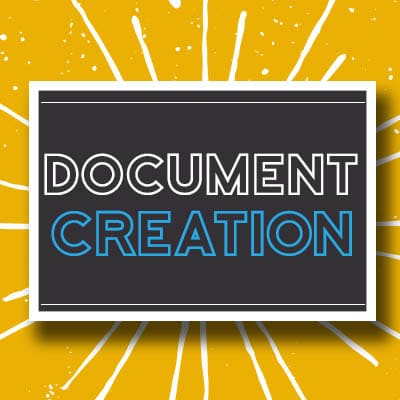
BONUS TIPS:
- Bonus Tip 1: Use hashtags for Twitter (minimum 2), pinterest (minimum 1), instagram (minimum 10)
- Bonus Tip 2: Image sizes for each platform: Facebook (1200x630px), Twitter (440x220px), Pinterest (600x1100px), Instagram (1000x1000px)
- Bonus Tip 3: Reposting Guidelines:
- Twitter – repost your tweet 5 days after the original post, 1 month after and then every 2 months after
- Facebook – repost your post 1 month after and then every 2 months after
FREE ANNUAL SOCIAL MEDIA PLAN TEMPLATE
SIGN UP below to download the FREE Annual Social Media Plan Template
Download the FREE Social Media Post Types Checklist – 30+ ideas here
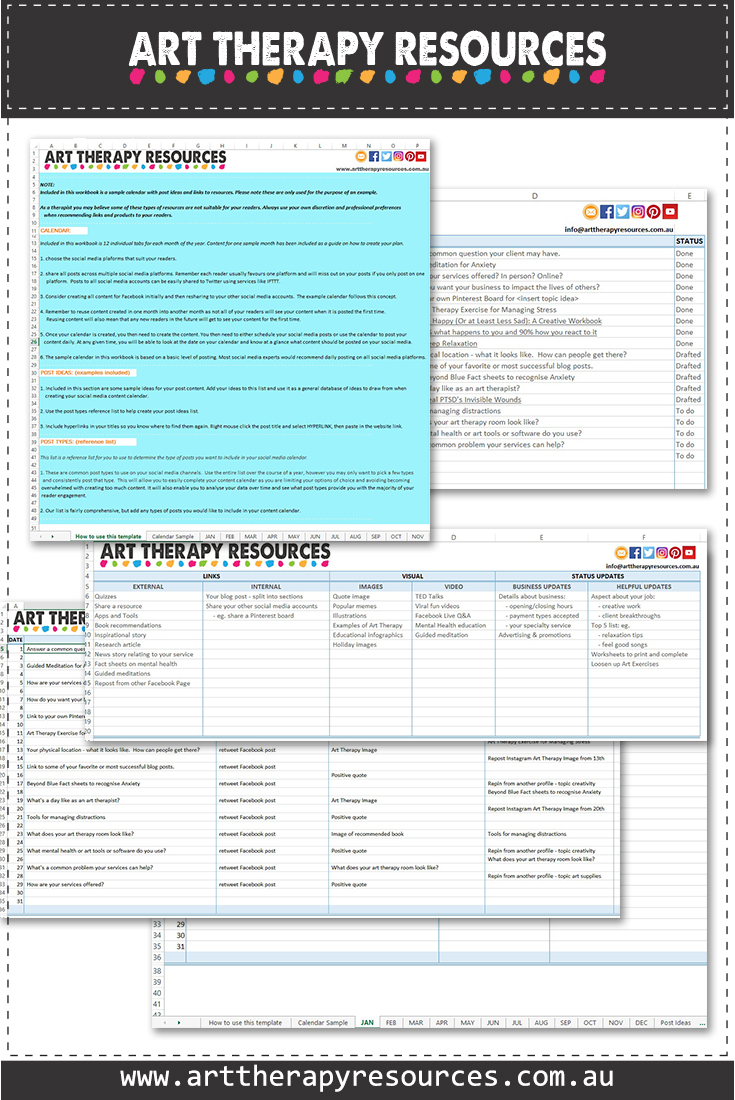
BUILD YOUR ART THERAPY REFERENCE MATERIALS:
Pin this image to your Pinterest board.
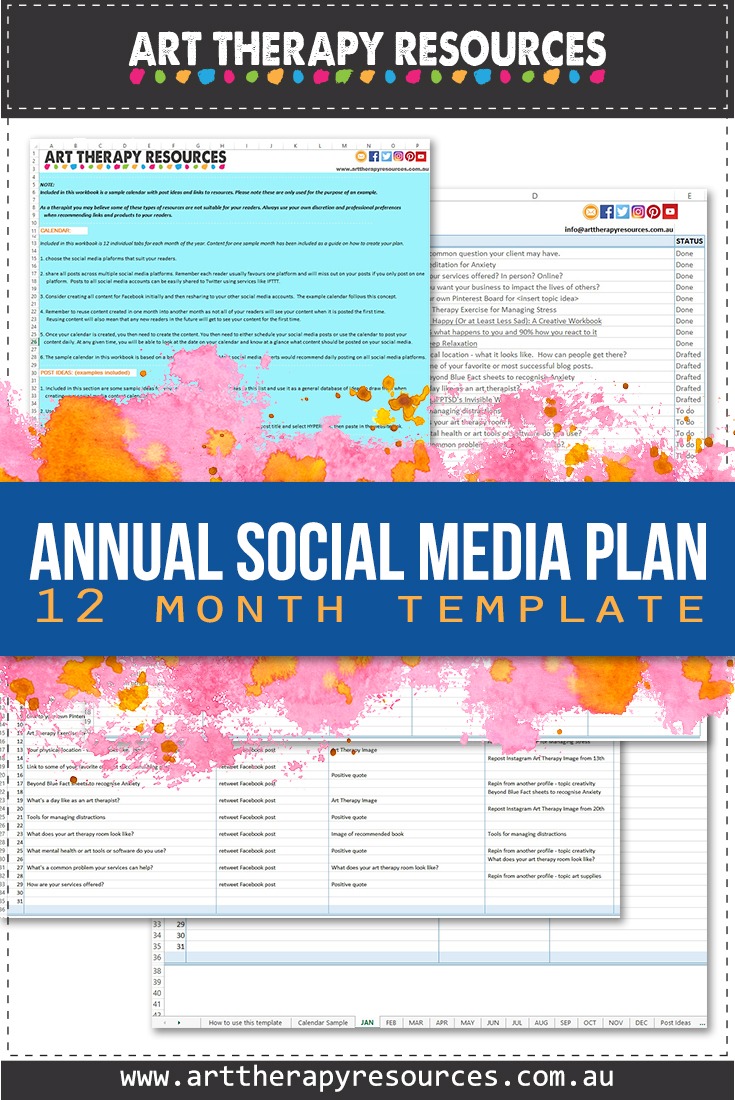
SHARE KNOWLEDGE & PASS IT ON:
If you’ve enjoyed this post, please share it on Facebook, Twitter, Pinterest. Thank you!
